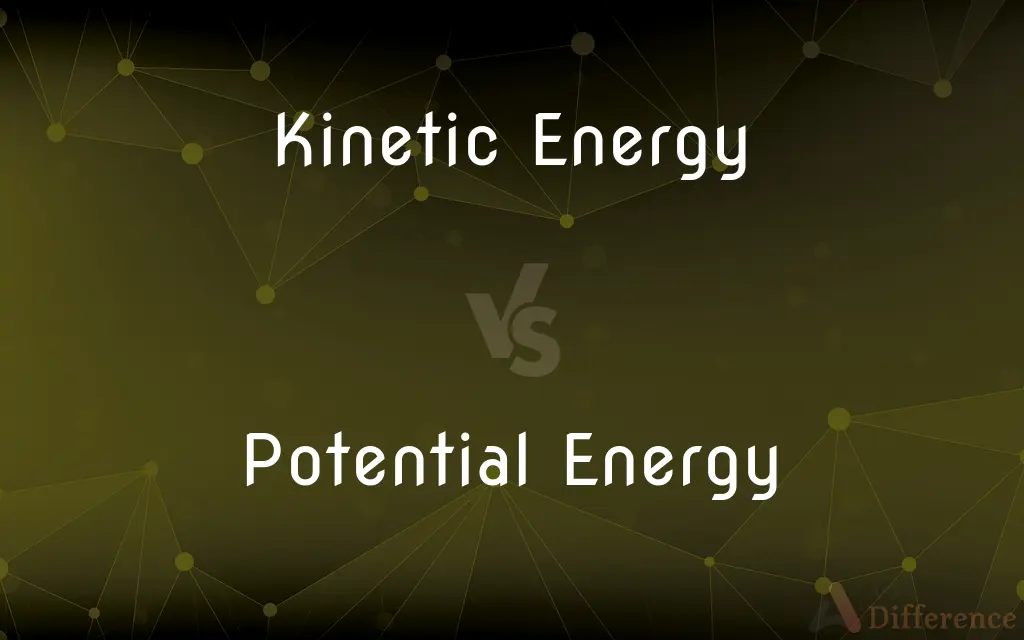Kinetic Energy vs. Potential Energy — What's the Difference?
By Tayyaba Rehman — Published on October 31, 2023
Kinetic Energy is energy due to motion, while Potential Energy is stored energy based on position or state.

Difference Between Kinetic Energy and Potential Energy
Table of Contents
ADVERTISEMENT
Key Differences
Kinetic Energy is directly associated with the motion of an object, while Potential Energy refers to the energy stored within an object due to its position or state.
When a ball rolls, it exhibits Kinetic Energy. However, when the ball is held at a height, it possesses Potential Energy, ready to be released when dropped.
Kinetic Energy and Potential Energy can transform into each other. For instance, as a pendulum swings, its Potential Energy at the topmost position converts to Kinetic Energy at the bottom-most position.
The faster an object moves, the greater its Kinetic Energy. In contrast, the Potential Energy of an object depends on factors like height in gravitational fields or charge in electric fields.
While Kinetic Energy primarily relates to motion, Potential Energy has various forms including gravitational, elastic, and chemical, among others.
ADVERTISEMENT
Comparison Chart
Definition
Energy of motion
Energy due to position or state
Measurement Factors
Depends on mass and velocity
Depends on factors like height or charge
Conversion
Can be converted to Potential Energy
Can be converted to Kinetic Energy
Examples
Moving car or spinning top
Stretched spring or water held at a height
Types
Primarily motion-related
Includes gravitational, elastic, chemical, etc.
Compare with Definitions
Kinetic Energy
Energy observed when objects are in motion.
The flying arrow exhibits Kinetic Energy.
Potential Energy
Energy that does work based on conditions that could trigger its release.
The water behind a dam holds vast Potential Energy.
Kinetic Energy
A scalar quantity described by the formula KE = ½ mv^2.
When calculating the Kinetic Energy of the baseball, the mass and velocity squared were considered.
Potential Energy
Energy possessed by an object that has the potential to be converted into kinetic energy.
The boulder atop the hill has considerable Potential Energy.
Kinetic Energy
Energy possessed by a body due to its motion.
The spinning wheel has Kinetic Energy.
Potential Energy
Energy stored due to an object's position or configuration.
The drawn bow has Potential Energy.
Kinetic Energy
Directly proportional to the mass and the square of the velocity of the object.
As the car accelerated, its Kinetic Energy increased substantially.
Potential Energy
A form of energy derived from relative position or arrangement.
A compressed spring possesses Potential Energy.
Kinetic Energy
The work needed to accelerate a body to its current speed.
It takes significant Kinetic Energy to propel rockets.
Potential Energy
Can be gravitational, elastic, chemical, etc. based on the cause of storage.
The Potential Energy of the charged capacitor is electrical in nature.
Common Curiosities
What determines an object's Potential Energy?
Factors like height (for gravitational), charge (for electric), or configuration (like a stretched spring).
On what factors does Kinetic Energy depend?
It depends on the object's mass and velocity.
What is Kinetic Energy?
Kinetic Energy is the energy an object possesses due to its motion.
Can Potential Energy be released?
Yes, when conditions change, like dropping a ball or discharging a battery.
Why do objects lose Potential Energy when they fall?
As they fall, their height and thus gravitational Potential Energy decrease, converting to Kinetic Energy.
What are examples of Potential Energy?
A charged battery, a stretched rubber band, and water behind a dam.
Can an object have both Kinetic Energy and Potential Energy simultaneously?
Yes, like a roller coaster at the top of a hill moving slowly.
How is Kinetic Energy calculated?
Using the formula KE = ½ mv^2, where m is mass and v is velocity.
How does Potential Energy differ from Kinetic Energy?
Potential Energy is the stored energy of position or state, while Kinetic Energy is due to motion.
Can Kinetic Energy transform into Potential Energy and vice versa?
Yes, the two can interconvert, as seen in a swinging pendulum.
Does a stationary object have Kinetic Energy?
No, stationary objects have zero Kinetic Energy.
Is Kinetic Energy always positive?
Yes, since it’s based on the square of velocity, it's always a positive value.
In what forms can Potential Energy exist?
Gravitational, elastic, chemical, nuclear, and more.
How are Kinetic and Potential Energy related in conservation laws?
The total energy (Kinetic + Potential) in a closed system remains constant, demonstrating the law of conservation of energy.
How can Potential Energy be increased?
By raising an object higher in a gravitational field or compressing a spring further.
Share Your Discovery

Previous Comparison
Bleu Cheese vs. Gorgonzola
Next Comparison
Dolphin Fin vs. Shark FinAuthor Spotlight
Written by
Tayyaba RehmanTayyaba Rehman is a distinguished writer, currently serving as a primary contributor to askdifference.com. As a researcher in semantics and etymology, Tayyaba's passion for the complexity of languages and their distinctions has found a perfect home on the platform. Tayyaba delves into the intricacies of language, distinguishing between commonly confused words and phrases, thereby providing clarity for readers worldwide.
















































